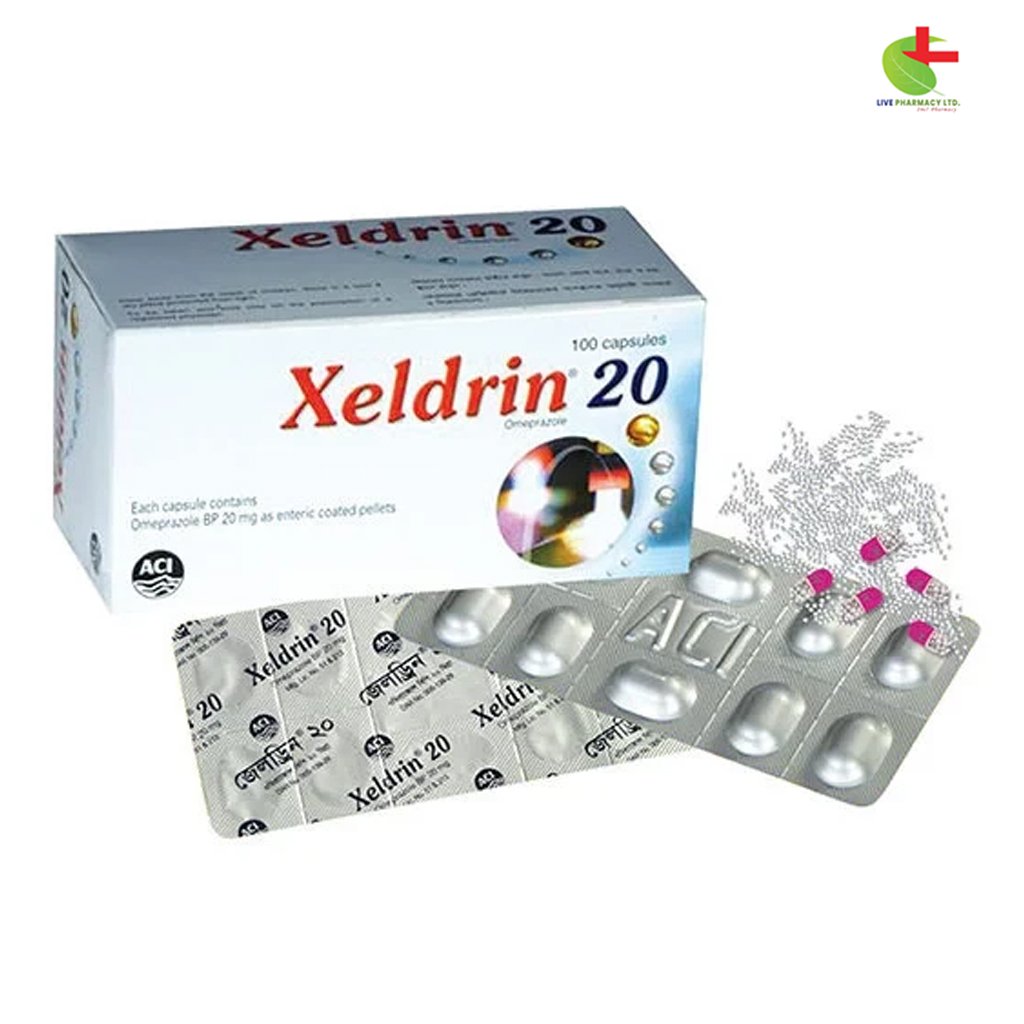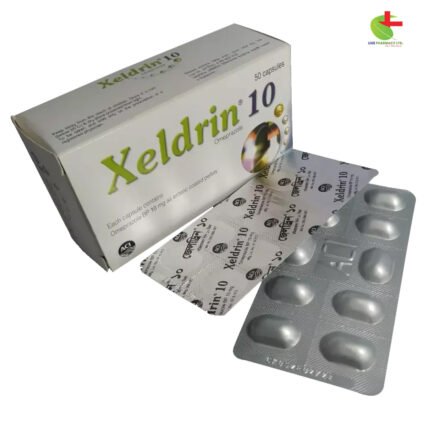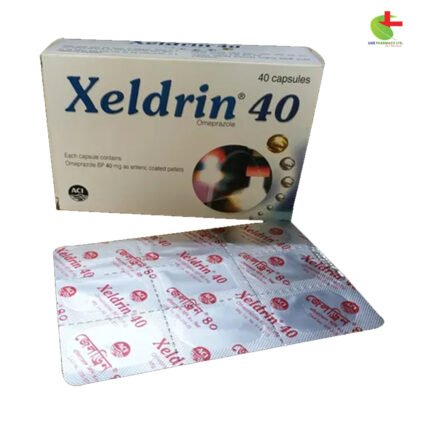Xeldrin 20
60.00৳ Strip
- Xeldrin contains Omeprazole, a proton pump inhibitor.
- Used to treat and prevent conditions like gastric ulcers, GERD, acid reflux, and Zollinger-Ellison syndrome.
- Reduces stomach acid production, providing relief from acid-related disorders.
- Available in both oral and intravenous forms.
- Plays a key role in eradicating Helicobacter pylori to heal peptic ulcers.
- Always follow a healthcare professional’s guidance for optimal results.
 Brand
Brand
|
ACI Limited |
|---|---|
 Generics
Generics
|
Omeprazole |
 Type
Type
|
Capsule |
Indications
Xeldrin is prescribed for the treatment and prevention of a variety of conditions, including:
- Gastric and duodenal ulcers
- NSAID-induced gastric and duodenal ulcers
- Prophylaxis in patients with a history of NSAID-induced ulcers
- Gastro-esophageal reflux disease (GERD)
- Long-term management of acid reflux
- Acid-related dyspepsia (indigestion)
- Severe ulcerating reflux esophagitis
- Prophylaxis against acid aspiration during general anesthesia
- Zollinger-Ellison syndrome
- Helicobacter pylori-induced peptic ulcers
Use as directed by a healthcare professional.
Pharmacology
Xeldrin contains Omeprazole, a potent proton pump inhibitor (PPI) that reduces gastric acid secretion. It works by blocking the hydrogen-potassium ATPase enzyme system in the stomach lining, effectively inhibiting acid production. After oral administration, the medication begins to take effect within one hour, reaching maximum potency within two hours, and continues to inhibit acid secretion for up to 72 hours. When discontinued, the acid secretion returns gradually within 3 to 5 days.
Dosage Instructions
Oral Dosage:
- Gastric & Duodenal Ulcers: 20 mg once daily for 4 weeks (duodenal ulcer) or 8 weeks (gastric ulcer). For severe or recurrent cases, increase to 40 mg daily. Maintenance dose for recurrent duodenal ulcers: 20 mg daily.
- NSAID-associated Ulcers: 20 mg once daily for 4 weeks, extend for another 4 weeks if necessary. For prophylaxis in patients with a history of NSAID ulcers, 20 mg daily is recommended.
- Gastro-esophageal Reflux Disease (GERD): 20 mg once daily for 4-8 weeks. For GERD resistant to other treatments, 40 mg once daily for 8 weeks is recommended. Maintenance dose: 20 mg once daily.
- Acid-related Dyspepsia (Indigestion): 10-20 mg daily for 2-4 weeks.
- Zollinger-Ellison Syndrome: Start with 60 mg once daily; dosage can range from 20-120 mg daily, divided into two doses for those requiring more than 80 mg.
- H. pylori Eradication for Peptic Ulcers: Omeprazole 20 mg twice daily in combination with antibiotics such as Amoxicillin (500 mg three times a day) and Metronidazole (400 mg three times a day) for one week.
- Pediatric Use (Severe Ulcerating Reflux Esophagitis): For children over 1 year: 10-20 mg once daily for children weighing 10-20 kg, and 20-40 mg once daily for those over 20 kg, for 4-12 weeks.
Intravenous (IV) Dosage:
- Acid Aspiration Prophylaxis: 40 mg IV slowly (over 5 minutes) one hour before surgery.
- Gastric/Peptic Ulcer & Reflux Esophagitis: If oral medication is not suitable, administer 40 mg IV daily.
- Zollinger-Ellison Syndrome (ZES): Start with 60 mg IV daily, adjusting as needed. Doses exceeding 60 mg daily should be divided into two doses.
Always consult a doctor before starting treatment.
Administration
IV Injection:
- Use Omeprazole lyophilized powder and water for injection strictly for intravenous use.
- Reconstitute by adding 10 ml water for injection to the vial containing the powder. Administer the solution slowly over 2-5 minutes at a rate of 4 ml/min. Use the freshly prepared solution within 4 hours.
IV Infusion:
- Dissolve one vial in 100 ml saline or 5% dextrose for infusion.
- Infuse over 20-30 minutes. Use within 12 hours (saline) or 6 hours (dextrose). Do not mix with other drugs in the same infusion.
Interactions
- Ketoconazole: Reduced absorption due to decreased gastric acidity.
- Diazepam, Phenytoin, Warfarin: Omeprazole may slow down the elimination of these drugs, requiring dose adjustments and monitoring.
- Clarithromycin: Increased plasma levels of Omeprazole can enhance efficacy during H. pylori treatment.
- Other drugs: Xeldrin has no significant interactions with caffeine, propranolol, amoxicillin, or antacids. Alcohol and food do not affect its absorption.
Contraindications
- Hypersensitivity: Do not use in patients with known allergies to Omeprazole.
- Malignancy: Exclude malignancy before starting treatment for gastric ulcers, as symptoms may be alleviated by the drug, potentially delaying the diagnosis.
Side Effects
Xeldrin is generally well tolerated, with most side effects being mild and reversible. Common side effects may include:
- Skin reactions: Rash, pruritus, photosensitivity
- Gastrointestinal issues: Diarrhea, constipation, nausea, abdominal pain
- Neurological symptoms: Dizziness, headache, insomnia
- Others: Dry mouth, taste disturbances, arthritic symptoms, reversible mental confusion in severely ill patients, and rare liver enzyme elevations.
Serious side effects (rare) include anaphylactic shock, hepatitis, interstitial nephritis, and hepatic failure.
Pregnancy & Lactation
- Pregnancy: Studies suggest no adverse effects on pregnancy or fetal health, but it should be used only when necessary.
- Lactation: No data on the passage of Omeprazole into breast milk. Discontinue breastfeeding if the medication is essential.
Precautions & Warnings
- Avoid co-administration with Clopidogrel due to reduced effectiveness of clopidogrel.
- Long-term use may be linked to increased fracture risk.
- In patients with liver disease, caution is advised.
Therapeutic Class
Proton Pump Inhibitor (PPI)
Storage Conditions
Store in a dry, cool place, away from light and heat. Keep out of reach of children.













Reviews
There are no reviews yet.